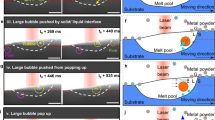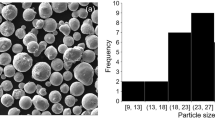Abstract
In addition to strain hardening and residual stress, damage influences the product performance of forward rod extruded parts. Damage is usually neglected and difficult to quantify. The evolution of ductile damage in metal forming is closely correlated to the load path. An experimental approach using automated energy dispersive X-ray spectroscopy (EDX) particle analysis in scanning electron microscopy (SEM) is used to successfully quantify the void area fraction and obtain information on ductile damage. The method is performed on forward rod extruded 16MnCrS5 workpieces with varying extrusion strains and shoulder opening angles (and thus varying underlying load paths). The quantified damage is directly correlated to the load path, which can be described by the stress triaxiality evolution during forming. Density measurements were performed to further validate the results. By observing the change of strain-weighted stress triaxiality and maximum stress triaxiality, it is shown, that the maximum stress triaxiality is the decisive parameter enabling void nucleation.



















Similar content being viewed by others
References
Lange K, Kammerer M, Pöhlandt K, Schöck J (2008) Fließpressen. Springer, Heidelberg
Jennison HC (1930) Certain types of defects in copper wire caused by improper dies and drawing practice. AIME Trans 89:121–139
Avitzur B (1968) Analysis of central bursting defects in extrusion and wire drawing. J Eng Ind 90(1):79–90. https://doi.org/10.1115/1.3604608
Zimerman Z, Avitzur B (1970) Analysis of the effect of strain hardening on central bursting defects in drawing and extrusion. J Eng Ind 92(1). https://doi.org/10.1115/1.3427698
Soyarslan C, Tekkaya AE, Akyuz U (2008) Application of continuum damage mechanics in discontinuous crack formation: forward extrusion chevron predictions. Zamm 88(6):436–453. https://doi.org/10.1002/zamm.200800013
Zimerman Z, Darlington H, Kottcamp EH (1971) Selection of operating parameters to prevent central bursting defects during cold extrusion. In: Metal forming: interrelation between theory and practice. Springer US, Boston, MA, pp 47–62
Rice JR, Trace DM (1969) On the ductile enlargement of voids in triaxial stress fields. J Mech Phys Solids 17(3):201–217. https://doi.org/10.1016/0022-5096(69)90033-7
Tekkaya AE, Ben Khalifa N, Hering O, Meya R, Myslicki S, Walther F (2017) Forming-induced damage and its effects on product properties. CIRP Ann 66(1):281–284. https://doi.org/10.1016/j.cirp.2017.04.113
Zapara M, Augenstein E, Helm D (2014) Prediction of damage in cold bulk forming processes. Pamm 14(1):1037–1040. https://doi.org/10.1002/pamm.201410492
Lemaitre J, Dufailly J (1987) Damage measurements. Eng Fract Mech 28(5):643–661. https://doi.org/10.1016/0013-7944(87)90059-2
Tasan CC, Hoefnagels JPM, Geers MGD (2009) A critical assessment of indentation-based ductile damage quantification. Acta Mater 57(17):4957–4966. https://doi.org/10.1016/j.actamat.2009.06.057
Tasan CC, Hoefnagels JPM, Geers MGD (2010) Indentation-based damage quantification revisited. Scr Mater 63(3):316–319. https://doi.org/10.1016/j.scriptamat.2010.04.018
Tasan CC, Hoefnagels JPM, Geers MGD (2009) A brittle-fracture methodology for three-dimensional visualization of ductile deformation micromechanisms. Scr Mater 61(1):20–23. https://doi.org/10.1016/j.scriptamat.2009.02.049
Shi YW, Barnby JT (1984) Void nucleation during tensile deformation of a C-Mn structural steel. Int J Fract 25(2):143–151. https://doi.org/10.1007/bf01141557
Cao TS, Maire E, Verdu C, Bobadilla C, Lasne P, Montmitonnet P, Bouchard PO (2014) Characterization of ductile damage for a high carbon steel using 3D X-ray micro-tomography and mechanical tests – application to the identification of a shear modified GTN model. Comput Mater Sci 84:175–187. https://doi.org/10.1016/j.commatsci.2013.12.006
Tasan CC, Hoefnagels JPM, Geers MGD (2012) Identification of the continuum damage parameter: an experimental challenge in modeling damage evolution. Acta Mater 60(8):3581–3589. https://doi.org/10.1016/j.actamat.2012.03.017
Raeymaekers B, Van Espen P, Adams FJMA (1984) The morphological characterization of particles by automated scanning electron microscopy. Microchim Acta 83(5):437–454. https://doi.org/10.1007/bf01451454
Laskin A, JPJAC C (2001) Automated single-particle SEM/EDX analysis of submicrometer particles down to 0.1 μm. Anal Chem 73(5):1023–1029
Mohr D (2015) Basic notions of fracture mechanics - ductile fracture [WWW Document]. ETH Zurich, Dep. Mech. Process Eng. Comput. Model. Mater. Manuf
Hering O, Kolpak F, Tekkaya AE (2019) Flow curves up to high strains considering load reversal and damage. Int J Mater Form 12(6). https://doi.org/10.1007/s12289-018-01466-z
Meya R, Kusche C, Löbbe C, Al-Samman T, Korte-Kerzel S, Tekkaya A (2019) Global and high-resolution damage quantification in dual-phase steel bending samples with varying stress states. Metals 9(3). https://doi.org/10.3390/met9030319
Nadolski D (2018) Einfluss des Herstellungsverfahrens und der Wärmebehandlung auf das Verzugsverhalten unterschiedlicher Bauteilgeometrien. Shaker, Aachen
Spitzig WA, Sober RJ, Richmond O (1975) Pressure dependence of yielding and associated volume expansion in tempered martensite. Acta Metall Mater 23(7):885–893. https://doi.org/10.1016/0001-6160(75)90205-9
Acknowledgements
The authors thank the German Research Foundation (DFG) for the financial support of subproject A02 and B04 in the Collaborative Research Centre TRR 188 “Damage Controlled Forming Processes” (Project number 278868966 – TRR 188).
Funding
This study was funded by the German Research Foundation (DFG), Project A02 and B04 in the Collaborative Research Centre CRC/Transregio 188 “Damage Controlled Forming Processes”.
Author information
Authors and Affiliations
Corresponding author
Ethics declarations
Conflict on interests
The authors declare that they have no conflict of interest.
Additional information
Publisher’s note
Springer Nature remains neutral with regard to jurisdictional claims in published maps and institutional affiliations.
Appendix
Appendix
In order to evaluate the influence of the process parameters on the damage evolution the influence of the load path during forward rod extrusion on an ideal void was studied numerically. For this an axisymmetric simulation model was set up in Abaqus CAE, representing a material point on the center line which travels through the forming zone during forward extrusion (Fig. 20).
The reference model has a diameter and a height of 2a. A spherical void was positioned in the center of the model. The evolution of the axial and radial stress components σz and σr occurring along the central axis during forward rod extrusion, determined in Finite-Element-Simulations performed with the software Simufact 13 (previous chapter), were applied to the boundaries of the reference model (Fig. 21).
Since the stress components are prescribed directly, the behavior of the reference model is not affected by the length a. In order to assure, that the void does not alter the resulting strain along the central axis, which is prescribed by the extrusion strain, its size was decreased incrementally, yielding an initial void radius of b = a/5. This way, the difference between the resulting strain in forward extrusion and the resulting strain in the reference model was less than 1%. It was studied how the shape and the volume of the void changes.
The shape of the ideal spherical void alongside with its shape change in dependence of the extrusion parameters is shown in Fig. 22. Higher extrusion strains lead to voids being increasingly stretched in extrusion direction. The direction of the distortion of the voids is the same for all extrusion strain due to the Lode parameter being identical (Fig. 22).
The change in volume of the voids caused by different extrusion strains and the corresponding triaxiality values are shown in Fig. 23. For comparison, the initial void volume is shown additionally. It can be observed that a small extrusion strain of ε = 0.1 leads to an increase of the void volume due to a positive triaxiality. For ε = 0.3 the void volume is similar to the initial void volume. With extrusion strains higher or equal than ε = 0.5 the mean triaxiality is negative. This causes a reduction of void volume after forming. For extrusion strains higher than ε = 1.2 a void volume of nearly 0 is reached because of highly negative triaxiality values.
The above mentioned method was repeated for different shoulder opening angles. This yields the advantage that the same strain is reached on the central axis of the extrudate and thus, there is only a change in the hydrostatic part. In Fig. 24 it is shown that only the volume of the void changes. The shape is the same due to identical Lode parameters and extrusion strains.
The change in volume of the voids with varying shoulder opening angles compared to the initial void volume is shown in Fig. 25. A correlation between triaxiality and void volume can be seen.
It is noted, that a real material shows no round spherical void. The simulation results merely show a general tendency on how an ideal spherical voids changes its shape and volume under the load paths of forward rod extrusion with different process parameters. The semi-finished products used for forward rod extrusion contain inclusions. Void nucleation occurs at these inclusions due to their breakage or due to the separation of the matrix/inclusion interface, resulting in variously shaped voids with different volumes. Nonetheless, in addition to this new voids will nucleate due to the interaction of plastic strain, hydrostatic pressure, matrix and inclusion.
Rights and permissions
About this article
Cite this article
Hering, O., Dunlap, A., Tekkaya, A.E. et al. Characterization of damage in forward rod extruded parts. Int J Mater Form 13, 1003–1014 (2020). https://doi.org/10.1007/s12289-019-01525-z
Received:
Accepted:
Published:
Issue Date:
DOI: https://doi.org/10.1007/s12289-019-01525-z










